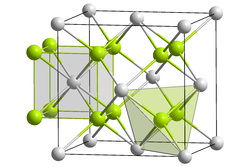Polonium (IV) oxide
| Crystal structure | ||||||||||
|---|---|---|---|---|---|---|---|---|---|---|

|
||||||||||
| __ Po 4+ __ O 2− | ||||||||||
| Crystal system | ||||||||||
| Space group |
Fm 3 m (No. 225) |
|||||||||
| General | ||||||||||
| Surname | Polonium (IV) oxide | |||||||||
| other names |
Polonium dioxide |
|||||||||
| Ratio formula | PoO 2 | |||||||||
| Brief description |
yellow or red crystals |
|||||||||
| External identifiers / databases | ||||||||||
|
||||||||||
| properties | ||||||||||
| Molar mass | 240.98 g mol −1 | |||||||||
| Physical state |
firmly |
|||||||||
| density |
8.9 g cm −3 |
|||||||||
| Sublimation point |
885 ° C |
|||||||||
| solubility |
Soluble in water |
|||||||||
| Hazard and safety information | ||||||||||
 Radioactive |
||||||||||
|
||||||||||
| As far as possible and customary, SI units are used. Unless otherwise noted, the data given apply to standard conditions . | ||||||||||
Polonium (IV) oxide , PoO 2 is the tetravalent oxide of polonium .
Extraction and presentation
The compound can be made by the direct reaction of polonium and oxygen at 250 ° C.
properties
Polonium (IV) oxide exists in two modifications, a yellow and red form. The former has a fluorite- like structure with the space group Fm 3 m (space group no. 225) and is stable at room temperature. The red variant has a tetragonal structure and is only stable at higher temperatures. Under reduced pressure, the oxide decomposes into the elements from 500 ° C. The radius of the Po 4+ ion is 1.02-1.04 Å .
When polonium dioxide is introduced into water, the poly acid H 2 PoO 3 is formed .
literature
- RH Steinmeyer, CJ Kershner: Vapor pressure of polonium dioxide . In: Journal of Inorganic and Nuclear Chemistry . September 1971, p. 2847-2850 , doi : 10.1016 / 0022-1902 (71) 80045-3 .
Individual evidence
- ^ A b c d e A. F. Holleman, Egon Wiberg, Nils Wiberg: Inorganic Chemistry . Academic Press, 2001, ISBN 0-12-352651-5 , pp. 549 .
- ↑ a b c d e William M. Haynes: CRC Handbook of Chemistry and Physics . CRC Press, 2011, ISBN 1-4398-5512-9 , pp. 4.81 .
- ↑ The hazards emanating from radioactivity do not belong to the properties to be classified according to the GHS labeling. With regard to other hazards, this substance has either not yet been classified or a reliable and citable source has not yet been found.